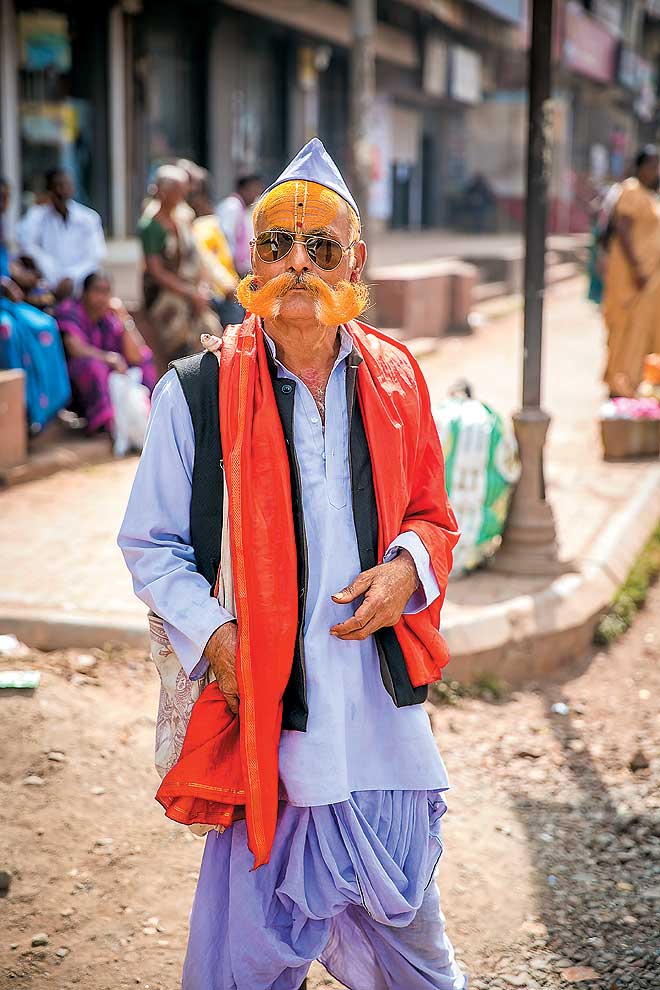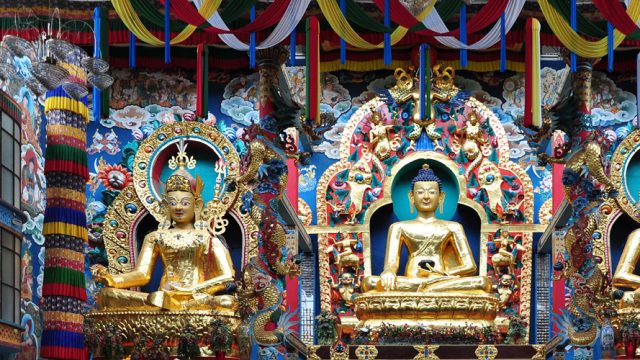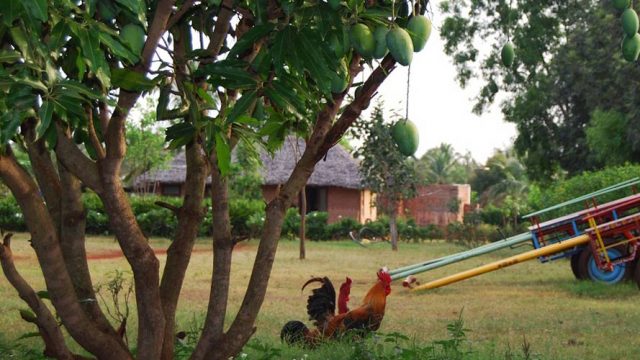I decide to fall in love with Dharwad at first sight, when I alight one morning from
I also soon learn that the town’s name means something like ‘a place where travellers can break long journeys and take rest’. Its location, roughly halfway between Bengaluru and Pune, near the border of Goa and the Western Ghats, means that many travellers pass through — though these days, few may bother to stop for long. Anyhow, being a man of logic, I quickly determine that this must be a perfect place to hang out for a few days.
It is this fortuitous decision that, over the next week, leads to my discovery of Dharwad’s many discreet charms. Leaving the station, I walk down a remarkably quiet and tree-lined street towards the city centre. The Deccan air is cool and although Dharwad doesn’t exactly rank as a ‘hill station’, it is nevertheless situated at an elevation of about 700 metres. As I get into town I notice that the streets are wide and there are hardly any traffic jams. (The fact that Dharwad’s twin city Hubli, 21km southeast, is the commercial and industrial hub hereabouts means that Dharwad has been able to retain its attractiveness.)
It doesn’t take me long to check into a pleasant, and pleasantly cheap, room at the first hotel I spot on my way, the Hotel Hoysala which is bang opposite the Kittel Arts College. After a quick bath, I set about exploring the town. But when I try my phone’s GPS and map software, I find that, inexplicably, Dharwad hasn’t been mapped and only appears as a blank dot by the NH4.
Therefore, to find my bearings, I ask for maps and guidebooks in the well-stocked bookshop right opposite the central bus stand, only to be informed by the proprietors — in very cultured English — that they do not have any information useful for tourists, but that I may try their competitor, a bookshop around the block, which turns out not to have any maps either. However, owners of both bookshops are happy to part with all vital data a tourist may need, such as where to get the best local gourmet food at rock bottom rates: a wholesome jolada roti meal. The answer to this question is: Wherever you are in Dharwad, there is always a khanavali around the corner. More on this phenomenal phenomenon later.
Eventually, I discover that there is indeed a tourist office off College Road, in the Department of Culture compound. It was set up some years ago but at the time I visited no staff had yet been appointed (though I do believe I saw someone sleeping on a chair inside when I tried peeking through the dusty window of the locked door). Somebody tells me that the reason the tourist office has remained closed ever since it opened is because no tourists come to Dharwad, which of course makes a lot of sense — the city doesn’t have any particular tourist attractions to speak of. Well, except for those jolada roti meals which I plan to talk about later.
The thing to do here is to walk about aimlessly, looking at old buildings in the streets, many of which are adorned with quaint architectural details such as wooden ‘monkey top’ awnings over the windows (which are rapidly vanishing in bigger cities), and the occasional temple or church. Although I am initially a little nonplussed about being in a town where there isn’t much to do or see, it very quickly starts to feel like a blessing that I can wander at will without being harassed by touts or getting stressed over sightseeing agendas. Instead I enjoy the good vibrations in the air and I seem to hear music everywhere. Indeed, there appears to be a local saying that goes something like this: “Throw a stone over your shoulder in Dharwad and it is sure to hit the house of either a poet or a singer.”
Dharwad has a reputation of being something of a cultural capital. It has many bookshops (though you would need to know Kannada to appreciate their stock) and it is the hometown of the late Kannada poet and Jnanpith awardee D.R. Bendre. Celebrated Bengaluru playwright and actor Girish Karnad also grew up here. In the leafy lanes you’ll find gurukuls for Hindustani classical music: legendary vocalist Bhimsen Joshi, the doyenne of Hindustani music Gangubai Hangal (a big radio star in the old days) and singer Mallikarjun Mansur who cut many bestselling 78 rpm discs for HMV in the 1930s, are just a few of the eminent luminaries to have emerged from this small town.
The British started several schools in the 19th century and just after independence the Agricultural and the Karnataka universities were founded in 1949, set in pleasant, leafy campuses on the outskirts. This means that Dharwad has a large student population, which adds vibrancy to it, and the perhaps most famous student from here is the software mogul Nandan Nilekani, who went to St Joseph’s School.
The universities house museums and so I spend an afternoon at the rather unknown but interesting Archaeological Museum (11am–5pm on weekdays; free entry) at the Karnataka University. There’s ancient pottery and terracotta from the area, including findings from an ongoing excavation at Halasi of a circa sixth century fortified settlement where the living quarters were equipped with terracotta drainage systems, proving that it’s a bit of a myth that Indian cities didn’t have proper plumbing in the years between Harappa and today.
I learn that the Dharwad area has been populated since the Paleolithic age, its ancient glory being connected to the empires of the Kadambas, the Chalukyas, the Rashtrakutas, and the Vijaynagar kings. It is further said that mighty rulers ranging from Adil Shah, Aurangzeb and Shivaji to Hyder Ali and Tipu Sultan all fought to conquer it. Even the Pandavas are believed to have resided here for some time. The town itself is thought to be almost a thousand years old and was apparently fortified 500 years ago, but however much I stroll around, I don’t see traces of anything even remotely resembling a fort. All those dynasties seem to have come and gone without leaving too much in the way of mementoes behind.
Later in the week, when I get a little bored with doing nothing in Dharwad, I hop on a bus to the village of Saundatti (39km; one hour) to the north. The tidy, ancient settlement of less than ten thousand inhabitants with a locally famous temple is a popular picnic spot. Here is a huge, beautiful lake, watched over by an impressively mysterious old fort. The views are best from the Yallammagudda hill that is crowned by the early-16th century Sri Renuka Devi Temple (also known as Yellamma Temple; 5km from the village), and although I hear that the right time to visit would be during the popular temple festivals, when devdasis and millions of pilgrims are supposed to gather here, I quite enjoy the quiet of a weekday morning, when only a handful of visitors line up to enter the tiny shrine.
Afterwards, back in Dharwad, I find yet another khanavali — the local name for a small canteen — for some more hearty food. Over the days, I’ve become totally addicted to jolada roti oota, the regional speciality. Before sitting down, one must buy a token or a coupon (as the case may be) worth a couple of bucks from a stern man who usually sits behind a counter at the entrance — for this is a cash first, food later business. Then you are served (on a thali or perhaps more typically on a banana leaf) the so-called jolada roti which is a hand-pounded soft and fluffy sorghum bread made of jowar flour, accompanied by a delicious eggplant curry known as badanekaayi yennegai. These eggplants are stuffed with spices and served in a scoop of delicious gravy. Side dishes usually include a spicy mix of sprouted gram, some deadly chutney pudis, rasam, curds and a fresh fenugreek leaf salad. It’s earthy, wholesome food that you can go on eating day after day.
Khanavalis worth looking up include Basappa Khanavali and Prabhu Khanavali (both near Court Circle), Natraj Khanavali (Line Bazaar), and then there’s one slightly anonymous khanavali next to the bus stand in the centre of town. Or just ask anybody for the nearest khanavali and you can’t go too wrong.
Even though the major food pleasures here are vegetarian, the carnivore will be happy to learn that superhot Savaji food is readily available. Despite having a reputation of not being too concerned with hygiene, the Savaji chefs cook up a treat for anybody who loves his mutton spicy. The grainy textures of the curries and special Savaji masalas go well with jolada roti and kushka rice, a meal that is guaranteed to set your brain fuming. A very satisfying non-veg thali can be had in Hotel Milan (next to Jubilee Circle on PB Road), and it is cheap. For a typical meal, you may be able to run up a bill of one hundred rupees.
For an in-between-meals snack, I find that there are many ‘tea clubs’ in town; some of these are able to provide me with an unusual gourmet tiffin — the benne dosa, a buttery dosa typical of Davanagere town in Karnataka.
At least once a day, preferably after a meal, it is good to have pedha, which is an item that is central to the local culinary heritage and famous all over Karnataka. This dark brown sweet, made of rich creamy milk, khoya, and lots of sugar, is sold in virtually every bakery in town, but supposedly the best variety is found at the multiple-award-winning Babusingh’s Line Bazaar Thakur Pedha, with a 150-year-old tradition to lean on. The current shop owners are the fifth generation to make a living out of pedha and keep their method of preparation a closely guarded family secret.
Although there are many other pedha specialists in town, who incidentally all claim to sell the ‘best’ pedha, Babusingh’s only real competition seems to be from the also very popular Mishra Pedha on Hubli Road (which even has an outlet in Bengaluru opposite Kanteerva Stadium). The sweet is typically sold in boxes of 250g, 500g and 1kg.
And so it happens that I do at last find my map — while eating pedha. Aptly enough, it’s a basic sketch printed at the bottom of a box of the iconic sweetmeat — in order for the customer to be able to find his way back to the Babusingh’s Line Bazaar Thakur Pedha shop. But at this point, with my tummy full and fulfilled, I would much rather go and take a nap under one of those ‘shady trees’ of which there’s an abundance in this town. One of the best places to enjoy the canopy of greenery is Sadhankeri Park on the Goa Road, which has a lake and apparently used to be a source of inspiration for D.R. Bendre, the great poet who lived nearby (and taught at the Vidyaranya High School, in those days known as Victoria High). As I munch my pedha, I mull over a few sweet lines from a poem by him, one of the 1,427 penned by this prolific writer, which I just downloaded to my phone:
“Let me my plight
Keep unto myself
And serve you
O, rasikh only its sweet song.
If only your heart
which is like sugar candy
Melts there to
Pour back to me
Some of its sweet taste.”
The information
Getting there: Dharwad is about 450km from Bengaluru on NH4. Dharwad’s more industrial twin city Hubli does have a smallish airport with Spicejet connections to Bengaluru and to Delhi via Mumbai. Hubli is about 30 minutes from Dharwad (there are frequent shuttle buses). A pleasant way to arrive is by rail; there are trains connecting Dharwad with Bengaluru, Mysore, Hyderabad, Thiruvananthapuram, Chennai, Mumbai, Ahmedabad and even Delhi and Kolkata.
Where to stay: Dharwad has several hotels and none of them is very expensive. Expect to pay about Rs 500-1,000 for decent budget rooms. I stayed at Hotel Hoysala (Rs 832 non-AC doubles; 0836-2445627) on PB Road, which was perfect value for money and I’d love to stay there again any day. Other central hotels include Brindavan Lodge (from Rs 393 doubles; 2441580) on Station Road and Hotel Mandhar Regency (hotelmandhar.com) on College Road. The more luxurious business hotels are in Hubli.
Where to eat: Sleepy as the town might be, there is a hint of some nightlife. My brother-in-law, who used to work in a bank in Dharwad, fondly describes the city’s somewhat rough bars as “good for psychedelic experiences”. So to round off a long day of walking and eating, perhaps one of the best places in town is the large rooftop hotel watering hole at Central Park on PB Road (which is very central but has no park). The snazziest pub in town seems to be the one at the Hotel Mandhar on College Road. An al fresco aficionado could opt for Ozone, set in a landscaped garden with rustic huts about 10km outside town down the road towards Hubli.
Davanagere
Dharwad
Hubli





